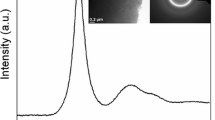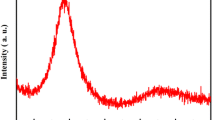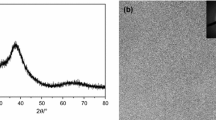Abstract
The crystallization kinetics and microstructural dynamics associated with devitrifying a melt-spun Cu50Zr50 metallic glass were investigated using isothermal treatments, in situ high-energy synchrotron X-ray diffraction, conventional and high-resolution transmission electron microscopy, and differential scanning calorimetry. The analysis of isothermal transformations allows us to more clearly unravel the complex interplay between nucleation and growth of competing stable and metastable phases. The isothermal devitrification response was found to involve the Cu10Zr7, CuZr2, and CuZr phases, consistent with previously reported constant heating rate experiments, but here we have resolved the phase evolution and structural characteristics of the transformation, including the very early stages of crystallization. At 671 K (398 °C), the isothermal transformation starts with the formation of the Cu10Zr7 phase, which grows in a generally equiaxed morphology. At a size of approximately 100 nm, the growth of the Cu10Zr7 particles is interrupted by the precipitation of a thin layer of the CuZr2 phase, upon which the metastable CuZr (B2) grows epitaxially. Crystallization kinetics are quantified here though in situ measurements (HEXRD, DSC) and ex situ microstructural analysis (TEM, HRTEM). Finally, the influences of chemical partitioning, diffusion, and crystallographic orientation on this sequence are examined.












Similar content being viewed by others
Notes
By this we mean the sample no longer features an amorphous fraction. This does not necessarily imply that the resulting crystalline phase(s) are the final products of a given phase evolution.
Unless otherwise indicated, the Cu10Zr7, CuZr2, and CuZr phases are assumed to exhibit the oC68, tI6, and cP2 (B2) structures, respectively.
The authors used a term, τ, associated with an incubation time: f C(t)=1−exp[−(k[t−τ])n].
We assume that such a low-temperature holding and rapid heating has a negligible effect on the subsequently measured thermal responses.
Specifically, the heating rate used to reach the annealing temperatures.
During this stage, small plate-like crystals also precipitated within the amorphous matrix. They were too small to be identified, and their effect on the crystallization pathway requires further investigation.
According to the JMAK expression, a valid cumulative distribution function, f should equal zero at t = 0, and approach one as t approaches infinity. Thus, df/dt is bell-shaped, equals zero at t = 0, and asymptotically approaches zero as t approaches infinity. A DSC trace is not likely to share the second and third properties exactly in common with df/dt, even if we account for the trace approaching a non-zero constant (C). However, the signal surrounding a thermal event is often fairly constant during isothermal annealing, and such a trace can be approximated fairly well by a scaled and shifted form of df/dt.
Via nonlinear regression.
With the exception of the 673.4 K (400.4 °C) dataset, the thermal analysis data were not altered prior to data fitting. The 673.4 K (400.4 °C) dataset warranted a background subtraction to remove a slight curvature that was imparted on the baseline by the instrument. This correction consisted of subtracting a signal that was measured under the same conditions as the 673.4 K (400.4 °C) ISO experiment, except in the absence of a specimen.
References
J. Eckert, J. Das, S. Pauly, and C. Duhamel: J. Mater. Res. 2007, vol. 22, pp. 285–301.
R. Hasegawa: J. Magn. Magn. Mater., 2012, vol. 324(21), pp. 3555–57.
Inoue, A. and Zhang, W. 2004 Mater. Trans. 45(2), 584–587.
R. Ray and B.C. Giessen, Scripta Metall., 1968, vol. 2 (6), pp. 357–59
Xu, D., Lohwongwatana, B., Duan, G., Johnson, W. L., and Garland, C. (2004) Acta Mater. 52(9), 2621 – 2624.
6.R.L. Freed and J.B. Vander Sande: J. Non-Cryst. Solids, 1978, vol. 27(1), 9–28.
D. Polk, C. Dube, and B. Giessen: The Effect of Oxygen Additions on the Properties of Amorphous Transition Metal Alloys, Defense Technical Information Center, 1978.
Kerns, A., Polk, D., Ray, R., and Giessen, B. (1979) Mater. Sci. Eng. 38(1), 49 – 53.
Buschow, K. H. J. (1981) J. Appl. Phys. 52(5), 3319–3323.
10.Z. Altounian, T. Guo-hua, and J.O. Strom-Olsen, J. Appl. Phys., 1982, vol. 53(7), 4755–4760.
Buschow, K. H. J. (1984) J. Phys. F: Met. Phys. 14(3), 593.
Dini, K. and Dunlap, R. A. (1985) J. Phys. F: Met. Phys. 15(2), 273.
M. Harmelin, A. Naudon, J.-M. Frigerio, and J. Rivory: in Rapidly Quenched Metals, S. Steeb and H. Warlimont, eds., Elsevier, Amsterdam, 1985, pp. 659–62
Kneller, E., Khan, Y., and Gorres, U. Mar 1986 Z. Metallkd 77(3), 152–163.
Stelter, E. C. and Lazarus, D. Dec 1987 Phys. Rev. B 36, 9545–9558.
Lu, H., Bao, C., Xue, Q., and Tang, D. (1991) Appl. Phys. A. 52(5), 302–306.
Ohshiro, H. and Arakawa, T. November 1994 J. Alloys Compd. 215, 251–255.
W.-N. Myung, H.-G. Kim, and T. Masumoto: Mater. Sci. Eng. A., 1994, Part 1(0), 179–180, 252–55.
A. Pratap, A. Prasad, S. Joshi, N. Saxena, M. Saksena, and K. Amiya: International Symposium on Metastable, Mechanically Alloyed and Nanocrystalline Materials (ISMANAM-94)/European Meeting on Disordering and Amorphization, Grenoble, France, June 27–July 01, 1994, Transtec Publications Ltd., European Union, Japan Soc Powder & Powder Met, Ecole Electrochim & Electromet Grenoble, Zoz Gmbh, Kurimoto Ltd, Int Sci Fdn, ISF, Grenoble, Switzerland, 1995, vol. 179, pp. 851–54.
E. Leonova, S. Kaloshkin, and I. Tomilin: Izv. Ross. Akad. Nauk. Ser. Fiz. 2001, vol. 65 (10), pp. 1420–23.
Lad, K., Maaroof, M., Raval, K., Pratap, A., and Raval, K. (2002) Prog. Cryst. Growth Charact. Mater. 45(1–2), 15–19.
Kwon, O., Kim, Y., Kim, K., Lee, Y., and Fleury, E. (2006) Metals and Materials International 12(3), 207–12.
Kwon, O.-J., Lee, Y.-K., Park, S.-O., Lee, J.-C., Kim, Y.-C., and Fleury, E. (2007) Mater. Sci. Eng. A. 449–51(0), 169–71.
Louzguine-Luzgin, D. V., Xie, G., Zhang, W., and Inoue, A. AUG 2007 Mater. Trans. 48(8), 2128–32.
25.N. Mattern, A. Sch ̈ops, U. Kuhn, J. Acker, O. Khvostikova, and J. Eckert: J. Non-Cryst. Solids , 2008, 354(10–11), pp. 1054–60.
Mehta, N., Singh, K., and Saxena, N. (2008) Phys. B 403(21–22), 3928–31
Wang, X. D., Jiang, Q. K., Cao, Q. P., Bednarcik, J., Franz, H., and Jiang, J. Z. (2008) J. Appl. Phys. 104(9), 1–5.
28.S. Pauly, J. Das, N. Mattern, D.H. Kim, and J. Eckert, Intermetallics, 2009, vol. 17(6), pp. 453–62.
Fernández, R., Carrasco, W., and Zúñga, A. (2010) J. Non-Cryst. Solids 356(33–34), 1665–69.
D.V. Louzguine-Luzgin, G. Xie, Q. Zhang, and A. Inoue: 2010 3rd International Conference on Characterization and Control of Interfaces for High Quality Advanced Materials, Amer Ceram Soc: Amer Ceramic Soc., Kurashiki, Japan, 2009, vol. 219, pp. 3–8.
Louzguine-Luzgin, D., Xie, G., Zhang, Q., Suryanarayana, C., and Inoue, A. (2010) Metall. Mater. Trans. A 41A, 1664–69.
Kalay, I., Kramer, M., and Napolitano, R. (2011) Metall. Mater. Trans. A 42A, 1144–53.
Mattern, N., Shariq, A., Schwarz, B., Vainio, U., and Eckert, J. (2012) Acta Mater. 60(5), 1946–56.
Cui, X., Zu, F., Wang, Z., Huang, Z., Li, X., and Wang, L. (2013) Intermetallics 36(0), 21–24.
J. Jang and C.O.C.T. Koch: Scripta Metall., 1989, vol. 23 (10), pp. 1805–10.
C. Tang and P. Harrowell: Nat. Mater. 2013, vol. 12(6), 507–11.
Zhou, S. and Napolitano, R. (2010) Acta Mater. 58(6), 2186–96.
Carvalho, E. and Harris, I. (1980) J. Mater. Sci. 15(5), 1224–30.
Acknowledgments
This study was supported by the U.S. Department of Energy, Office of Basic Energy Science, the Division of Materials Sciences and Engineering. The research was performed at the Ames Laboratory. Ames Laboratory is operated for the U.S. Department of Energy by Iowa State University under Contract No. DE-AC02-07CH11358. Synchrotron experiments were performed at the Advanced Photon Source, Argonne National Laboratory, under Grant No. DE-AC02-06CH11357. The authors thank Will Landau (Department of Statistics, Iowa State University) for assisting with the development of the “direct” JMAK fitting procedure.
Author information
Authors and Affiliations
Corresponding author
Additional information
Manuscript submitted March 31, 2014.
Appendix: JMAK Fitting Procedure
Appendix: JMAK Fitting Procedure
The magnitude and the overall shape of thermal analysis measurements depend on a variety of factors, some of which are related to the specimen itself (such as its geometry, mass, and thermal history), while others are related to the specific instrument and heating steps that are used. Nonetheless, isothermal reactions measured by differential calorimetry (DSC, DTA, etc.) frequently exhibit bell-shaped signals superimposed on a relatively constant baseline signal associated with maintaining the temperature of interest. A common method for determining the JMAK parameters (k and n) from constant temperature data involves computing a normalized cumulative integral over the thermal analysis event (peak) that corresponds to the IT of interest. These methods assume that the magnitude of the measured signal is directly related to the transformation rate. A plot of the normalized cumulative integral (of a bell shaped curve) vs time is sigmoidal, equaling zero at the lower integration bound and equaling one at the upper integration bound. Such a curve can be fitted to the JMAK expression, f(t) = 1 − exp [−(kt)n], to determine the reaction rate constant, k, and Avrami exponent, n. This type of analysis assumes that the normalized cumulative integral corresponds with the time-dependent volume fraction of the system that has transformed. An alternative analysis involves plotting ln(− ln(1 − f)) vs ln(t) and computing k and n from the slope and intercept of the log-linearized expression for f (t): ln(−ln(1 − f)) = n ln(k) + n ln(t).
Although constant temperature thermal analysis measurements often seem to be ideally shaped for such analysis, they tend to exhibit features and artifacts that must be addressed in order to ensure that a fit is accurate. Perhaps the biggest challenge involves accounting for a nonconstant baseline signal,Footnote 7 even when an instrument background signal is subtracted. This is especially problematic when the transformation of interest occurs so rapidly that the measured signal associated with the instrument ramping to the isothermal holding temperature overlaps the signal for the transformation of interest. This is usually not an issue for slower transformations where sufficient time is available for the instrument to establish a relatively constant baseline signal prior to, and after, the transformation of interest. In either case however, proper analysis requires careful truncation, since the fitting results for the methods described above are sensitive to the choice of integration bounds, as we demonstrate in Figure 13(c) through (f). This is especially true for the log-linearization method, where the logarithmic plot is linear over a smaller range as the amount of truncation increases, as shown in Figure 13(e) for the fitting of our raw 688.1 K (415 °C) isothermal dataset. The nonlinear artifacts that arise in the logarithmic plot introduce the need to further limit the amount of data that is considered when constructing a line from which n and k are computed (Fig. 14) .
(a) Raw isothermal [688.1 K (415.1 °C)] devitrification data measured by DSC. Note that the initial transient signal that persists after the program changes from a ramping [100 K/min (100 °C/min)] to isothermal mode. For mathematical convenience, we present the data here such that exothermic events result in positive deflections from the baseline signal. The indicated points denote the lower and upper bounds for the data truncation scenarios that we consider for this demonstration. The fitted values that we report in Table III are based on truncating the raw data to include only the points greater than one percent of the peak height on both sides of peak (listed as 0.010 in this figure). (b) Approximated DSC traces constructed from the expression for \( \dot{Q} \) using the JMAK parameters obtained by fitting portions of the raw DSC data directly. This was carried out for the various truncation scenarios and superimposed on the raw data (solid black curve). The plot has been rescaled to omit the data corresponding to the initial transient. Note that fits obtained in this manner are relatively insensitive to the range of truncation conditions investigated here. (c) The normalized cumulative integrals calculated from the raw data in (a) for the various truncation scenarios. Note that the plot and ultimately the fitted parameters, k and n, are sensitive to the values selected for upper and lower integration bounds. (d) Approximated DSC traces based on the k and n values obtained from the curves in (c) to the expression for f(t). They are plotted here using the same S and C values obtained for the direct fitting results of (a), since S and C values are not computed when fitting the fraction curves to f(t). (e) Logarithm plot of the curves presented in (c). Note the increased nonlinearity as the extent of data truncation increases. (f) Approximated DSC traces based on the n and k values computed from the slope and intercept of the lines corresponding with the points indicated in (e). These points were arbitrarily selected such that they visually represented the largest linear portion of each plot. Again S and C values for (f) were the same as those from the direct fitting procedure
k (a) and n (b) values plotted vs the truncation value (fraction of peak height) for the various fitting types demonstrated in Fig. 13 Direct (□) refers to fitting the raw, but truncated, DSC data to the expression for \( \dot{Q} \) (Fig. 13(a), (b)). Fraction (○) refers to fitting the normalized cumulative integral (fraction curve) to the expression for f(t) (Fig. 13(c), (d)). Log (∆) refers to computing n and k from the slope and intercept of normalized cumulative integral values presented on log scales (Fig. 13(e), (f))
To avoid the complexities associated with data truncation, we have computed the JMAK parameters n and k from the raw isothermal DSC signals (with the exception of the 673.4 K (400.4 °C) dataset, as we describe below). We begin by considering the time derivative of the JMAK expression, df/dt, which is essentially a probability density function for the cumulative distribution function f(t). In order to approximate an isothermal DSC signal, \( \dot{Q} \), we scale and shift df/dt by the factors S and C, respectively. Thus,
FittingFootnote 8 this expression to an isothermal DSC signal with a relatively constant baseline results in n and k values that (i) are less sensitive to the extent of data truncation and (ii) describe the DSC traces with high accuracy, as we demonstrate in Figure 13(b) for four different truncation scenarios. This method was applied to each of our rawFootnote 9 isothermal datasets, resulting in fitted parameters that are listed in Table III. For each fitting, the corresponding dataset was truncated such that only the points surrounding the isothermal peak down to one percent of the peak height were considered.
Rights and permissions
About this article
Cite this article
Cullinan, T., Kalay, I., Kalay, Y.E. et al. Kinetics and Mechanisms of Isothermal Devitrification in Amorphous Cu50Zr50 . Metall Mater Trans A 46, 600–613 (2015). https://doi.org/10.1007/s11661-014-2661-y
Published:
Issue Date:
DOI: https://doi.org/10.1007/s11661-014-2661-y






